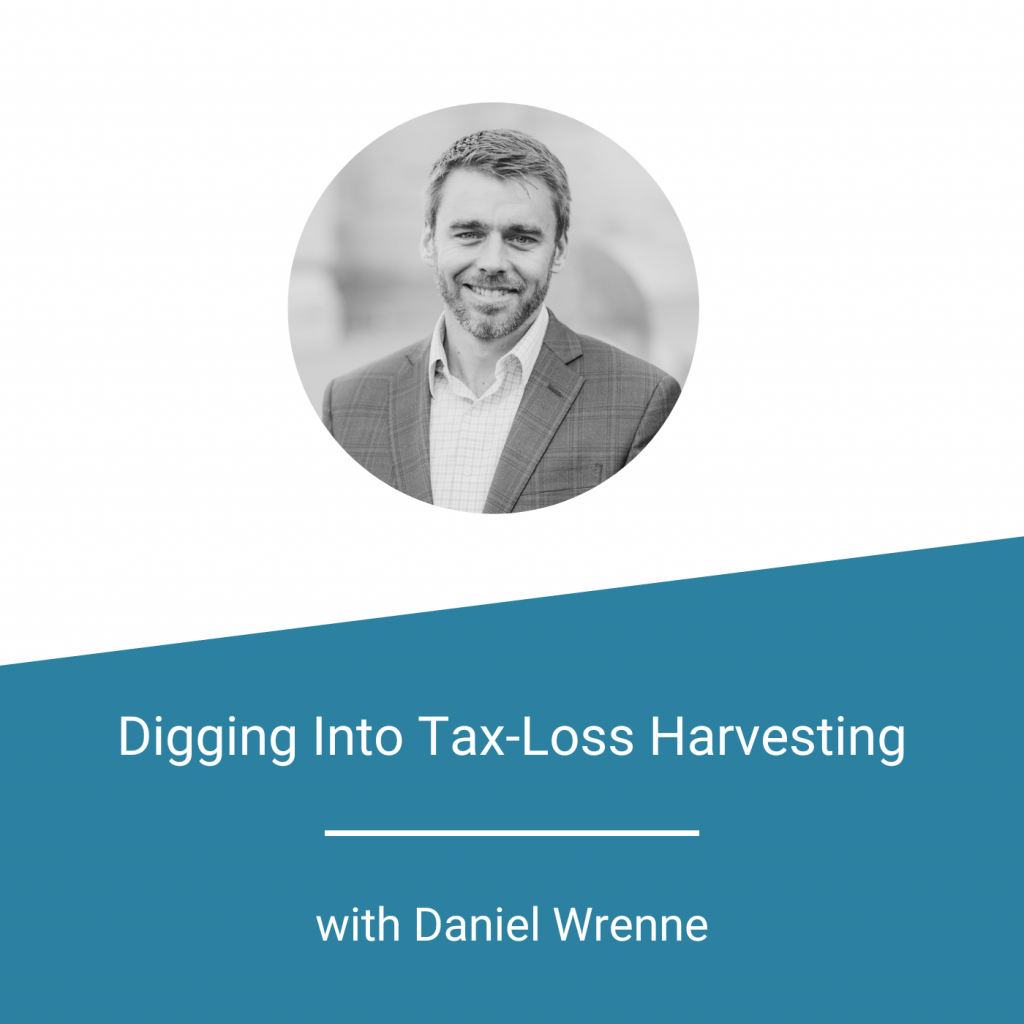Tax-loss harvesting is a tax strategy, but how does it actually affect your tax return and are there any limitations?
In this episode of the Finance for Physicians Podcast, Daniel Wrenne talks about tax-loss harvesting—what it is, why it’s beneficial, and how it works on your tax return.
Topics Discussed:
- Tax-loss Harvesting: Only beneficial for those with taxable assets
- What is tax-loss harvesting? Book losses while staying with similar investments
- Wash-Sale Rule: Why the IRS won’t let you buy the same security back
- What are the benefits of tax-loss harvesting?
- Take up to $3,000 a year of capital losses to offset ordinary income
- Defer or postpone taxes on normally taxed investment account
- Give it away to a nonprofit or beneficiary to realize step-up in basis
- How does tax-loss harvesting work on taxes? Form 1040, Line 7, Schedule D
Links:
Contact Finance for Physicians
Full Episode Transcript:
Hello, everyone. I hope you’re having a great day. Today, I was hoping to cover a question that’s come up quite a few times in our work with clients one-on-one. One of you brought up the question specifically, so I wanted to make sure and maybe dig into this a little bit more.
The question is about tax-loss harvesting, understanding that a little bit more, how it works into your tax return, and some of the specifics of how that works. I’m going to dig in a little bit today and cover that. For any of you guys that are either doing that or interested in it, I think this will be something to check out and hopefully get a little bit of knowledge on this. We’ll jump into that now.
Like I said, we’re going to talk a little bit more specifically about tax-loss harvesting. I’ll start out with just a brief summary of what it is and why it’s beneficial, and then we’ll talk about how it actually comes into play on your tax return. This is a tax strategy, so that’s a really good question. It’s like, well, how does this actually affect my tax return? We’ll talk about that and any limitations around that.
For starters, it’s important to clarify that tax-loss harvesting is only beneficial for those of you that have taxable assets. That’s an investment account in your name. It could be a brokerage account. It could be cryptocurrency. It could be a baseball card. You could buy and sell baseball cards. That’s technically a taxable asset.
A taxable asset is anything that’s invested not in a tax-sheltered account. A tax-sheltered account is like a Roth IRA, 401(k), 529, those kinds of things. Tax-loss harvesting is only beneficial for taxable assets, typically a brokerage account or a joint investment account—sometimes it’s called that—an investment account in your name or you and your spouse’s name. That’s an important clarification.
Also, to clarify, the best tax strategy really that there is is to maximize tax-sheltered vehicles first. Tax-loss harvesting is great, but I’ve seen on multiple occasions where people are looking into tax-loss harvesting and maybe have taxable assets like I just talked about, but they haven’t yet maximized those tax shelters. Oftentimes, it’s even more efficient to just go ahead and max out all your tax shelters or make sure that you’re not missing out on any tax shelters like work retirement plans, Roth IRAs, backdoor Roth IRAs, and that kind of stuff.
We’ve talked about that a lot before in prior episodes, but I just wanted to point that out today. Preferably, you’re using those tax shelters first. What often happens for you guys with higher income or good savers is you max out those tax shelters pretty quick and then your backup option is using taxable assets. That’s where tax-loss harvesting comes into play.
So what is it? I’m going to throw out a pretty basic example just to make sure the concept is clear. Let’s say you buy a mutual fund or ETF, same thing. You buy a Vanguard Total Stock Market Mutual Fund for $100 or buy $100 worth of it. Let’s say the market tanks and the value of it drops to $50. Now, it’s worth 50. Let’s say you decide to sell it at $50. At that point in time—you sell it at 50—you basically booked a loss of $50.
That’s really all a tax loss is. You’ve booked that loss. But then the question is, well, what do we do with the $50? Most of the time, you don’t need the cash, so we need to get it reinvested. We don’t want it to just sit around. The back end of the strategy is you’re immediately buying similar security. Maybe you buy the Vanguard 500 Index with the proceeds from that sale immediately so that you’re never really out of the market for long and you’ve basically booked that $50 loss.
At the end of the day, you still have a very similar investment as before, but you get that $50 tax loss. As we’ll talk about, it can come in handy. It can be beneficial for you to go ahead and take that tax loss. Essentially, what the strategy is is you’re booking losses while still staying invested.
Some of you might be thinking, okay, well, why didn’t you just buy the same thing back? What’s up with buying something a little different? There are a few rules. The main one you got to watch out for is called the wash-sale rule. There’s an IRS guideline that you can’t buy the exact same security back.
In this example, you can’t just go buy back the same Vanguard Total Stock. You can, but they disallow it. In order to get the loss, you can’t buy the exact same security back within 30 days. If you want to keep your investments invested, which is typically a good idea, you have to buy something that’s not the exact same thing but is somewhat similar. Some people get hung up on this. Basically, just don’t buy the exact same security back if you want to do this.
I think as a general rule of thumb, a good safe way to play it is to buy something that is slightly different and attracts a different benchmark maybe. That’s always safe. I don’t know of anyone that’s ever been audited for this. I haven’t heard of this being a concern of the IRS. I think it’s only an issue when you are buying back that same exact security. In that case, the brokerage firms will typically flag it and disallow it.
The IRS has a lot of stuff going on. They have bigger fish to fry, so I’m sure this is a pretty low priority for them. As long as you’re buying something that’s not the exact same thing and relatively similar, that typically works. I think that’s a fair approach. At the end of the day, you get the tax loss and it can help you with your taxes.
Why is it beneficial? That’s an important question. Now, there are a few different potential benefits. The first big benefit is that you can book up to $3000 a year of capital losses and offset them against ordinary income on your tax return. I’ll talk about where it comes through on the tax return in a second, but every year, you can take up to $3000 of capital losses, and then that’s going to offset some of your normal income on your taxes.
Normally, ordinary income has a higher percentage tax rate than capital gains tax rates. When we’re talking about taxable assets, those fall under the capital gains tax rules, so your normal income falls under ordinary income tax rules. Ordinary income taxes are typically a higher percentage rate than capital gains tax rates. If you can take a loss on something that’s taxed normally—just throwing out an example—at 20% and you can use that loss to offset something that’s normally taxed at 30%, that’s a win.
Taking at least $3000 of capital losses each year is one of the few tax arbitrage routes you can take. It’s not a huge number, but it is definitely very beneficial for a lot of people and it’s worthwhile to at least get that $3000 a year.
That’s the first benefit of tax-loss harvesting. As long as you can harvest at least $3000 a year, that’s a great thing because you’re able to offset it with something that’s more heavily taxed than the asset that you’re using to do it.
The question that you might think about is okay, well, what if I take more than $3000? Say you have $10,000 of tax losses. You’ve harvested $10,000 throughout the year of tax losses and you’re only able to take $3000 against income, so $7000 is still left over from tax losses. What happens is you can basically stockpile those, carry forward them as what they call it, and use them in the future either to offset the $3000 per year that you at least want to do—which we just talked about—or to offset capital gains that you receive in the future.
Basically, the more losses you take, you can defer the taxation on that taxable investment account or asset. It’s a way to postpone ultimately getting taxes because inevitably, if you do eventually take the money out of the account yourself, there would be some tax implication. By taking these losses, you can push that forward.
This is especially a win if you’re in a higher tax bracket now than when you ultimately take it out. It can get technical. It depends. There are some scenarios where this is not quite as beneficial, especially when you’re in a low bracket now and higher in the future.
This is not a benefit for everyone, but it can be a huge benefit. For most higher-income people that are likely in a high tax bracket now, it is typically a concrete benefit. The end effect of that is it just allows you to further defer or postpone taxes on that normally taxed investment account when you ultimately start to take it out.
The third big benefit of tax-loss harvesting is definitely the biggest benefit if you go down either one of these paths. It’s extremely beneficial if you ultimately either give it away to a nonprofit 501(c)(3) or you pass away with the account fully in your name. In that case, it’s extremely beneficial.
I’ll talk through a scenario to explain this third benefit and why it’s beneficial. Going back to Vanguard Total Stock Market—we’ll just stick with that example—let’s say you bought $50,000 of the Vanguard Total Stock Market and over the years of owning it, it has doubled. It’s turned into $100,000. If you’ve done nothing, you have $50,000 of unrealized or untaxed gains.
Now, if you pass away with that Vanguard Total Stock Market, what happens is whoever your beneficiary receives the $100,000 and they get what’s called a step-up in basis. That wipes off that unrealized taxable gain.
In other words, if you were alive and had $100,000 of this Vanguard Total Stock Market that had started at $50,000 and you sold it all, you’d have to pay tax on the $50,000 of gains because it has grown and it has not been taxed yet. But if you pass away and your heir receives it, they get the full $100,000 and they get the step-up in basis, which basically means like they bought it for $100,000, so they have a zero taxable gain if they sold it all immediately. If they let it grow to $200,000, they have a $100,000 base, so that’s a $100,000 gain. When you pass away with taxable assets, that step-up in basis is beneficial.
I’ll talk about why tax-loss harvesting amplifies this in a second, but the same thing happens when you give it to a 501(c)(3) nonprofit organization. In the same example, if you give that $100,000 away to a 501(c)(3), it’s a zero tax situation for you, of course, and the organization that receives it gets a step-up in basis essentially. They’re not going to pay tax on receiving that at all either.
In either of those two scenarios, it’s a way to basically sweep that future tax liability off your balance sheet, your heirs’, or whomever. For example, if you’re going to pass away with the assets or if you already give money, these sorts of things are great ways to do those things. It’s great because you’re able to sweep that $50,000 unrealized or future tax obligation off the table.
Back to tax-loss harvesting, it’s even better if you tax-loss harvest. Let’s say over the years, you’ve used this strategy of selling things when they’re lower and then buying something back that’s somewhat similar. If you’ve been tax-loss harvesting over the years, let’s say you took $20,000 in losses on that same Vanguard Total Stock Market Fund, you pass it on to your heirs, or give it to a 501(c)(3)—either one of those. You basically are sweeping $70,000. It’s worth $100,000, you paid $50,000 for it, but then you took losses of $20,000, so the basis as what they call it is $30,000 and the value of it is $100,000.
If you’re alive and you just sold it, you would be paying taxes on the $70,000, but if you give it away to a 501(c)(3) or you pass away and they get the step-up in basis, the same thing happens. You’re sweeping that $70,000 off your plate and it’s a way to avoid the tax on that $70,000 gain.
First of all, it’s very efficient if you’re going to give this security away and if you’re going to pass away with assets. This is an efficient asset to pass and it’s especially beneficial. If you’re going to do that, you’re going to give these kinds of things away, or you’re going to pass it to your heirs, it’s especially beneficial.
Basically, the more you can tax-loss harvest, the better because you get to use those tax losses while you’re alive. You can use it to offset some other investment that went up and sell it without paying tax, or offset $3000 a year on your tax return. That’s like a home run tax-wise for those of you that give some—especially the more you give—or for those of you that want to pass an inheritance. That makes the tax-loss harvesting.
The first two things I talked about like taking that $3000 loss a year are nice. It’s a little gravy on top. It’s well worth it, but it’s not a home run. The second benefit of deferring tax on that taxable account is pretty good. It can be really good depending on the situation, especially the longer you do it.
The third benefit we just talked about is a home run if it fits into your situation. Basically, you’re wiping that big tax obligation off your plate and still getting the benefit of those tax losses prior to that, so that works very well.
How does it work on your taxes? When you take these losses each year—let’s say you’ve been tax-loss harvesting, you need to go do your taxes, or you’re reviewing your tax return to your accountant to put it together for you—where does it come through?
If you look at your tax return—1040 is the form, that’s the main form on your tax return—it’s usually the first two pages of your tax return. If you look at 1040, the line where this all happens is Line 7. Line 7 is capital gain or loss. It says, attach Schedule D if required. If not required, check here. That’s where it all comes through. If you’ve been rocking it out on tax-loss harvesting and you’ve not had some other gain that wiped them all out, that line is going to show -$3000 because that’s the max.
When we’re working with clients, especially when we start working with them, it’s extremely rare that I see -$3000 on that line even when they have taxable accounts. It’s just because not many people are doing this, even advisors. We’ll see $5000, zero, or whatever all over the place. When you see -$3000, that’s a pretty good sign that that individual has been proactively doing tax-loss harvesting.
For my return, even for my own stuff, my goal is for it to stay -$3000 every year. That’s where it all comes through on Line 7. It says, refer to Schedule D. Schedule D is where the details come through. If you look at Schedule D, that’s where you’ll see all this spelled out—how much realized capital gains, how much realized capital losses, whether it was short-term or long-term, those offsets, and then this final number is basically the net of all the capital gains and losses. That’s what comes through in Section 7. Schedule D is where the details go. Section 7 on the main page is where you’re going to see the final number.
Now, if you’re taking a lot of losses, sometimes, what people will ask or wonder is how long can I just keep stockpiling these things? All of these I’m throwing out there would be good to talk to your accountant about because first of all, this stuff changes. I’m not an accountant. This is my disclaimer section. Talk to your account and refer to them for tax advice. This stuff changes. Also, your circumstances are also important to take into consideration, but as of now, under the current tax laws, these tax losses are indefinite. You can stockpile as many as you want and defer them as long as you want. That’s how it works, which is nice.
There is one big exception where this strategy, I would stay away from it. It can almost be like you should do the reverse. If you’re in a low enough tax bracket, capital gains tax rates actually go to 0%. In some rare cases when your income is low enough—say you’re in training and you happen to have a taxable investment account—it’s actually better to harvest gains on these kinds of accounts up to a certain level because it’s like, shoot, if I’m going to get taxed 0% on the gain, then I’ll take it. But this is pretty rare. I’ve seen it several times before, but it’s not the most common situation.
Normally, in that situation, when income is lower, it’s going to be much better to max out tax shelters. Those are plenty. They will typically do the job on what you want to save.
If you’re in that situation where you happen to have that taxable investment account and you happen to have low income for one year or multiple years, it might be that it’s actually better to call it a tax-gain harvest. Take those gains if you’re up to the point where they’re in the 0% tax rate. That works out even better.
Like I said before, anytime we’re talking about tax, it’s always good to talk to your advisor or your tax professional because all these things tie into your circumstances and it’s important to incorporate that.
That’s tax-loss harvesting. There’s definitely a lot to it. It’s somewhat straightforward, but there are a lot of concerns about the IRS, the part about what they require. That wash-sale rule is a little concerning for people. That’s probably the number one concern we see with people. It’s like, how do I avoid this wash-sale thing? I don’t think that should be a huge concern.
I think the bigger thing is making sure you incorporate your situation and really understand the cost-benefit of it. For a lot of people, it might not be worth the headache to even mess with that. A lot of people are better off just maxing out these tax shelters that are already available and don’t even have to mess with this.
In other cases, like I said, maybe you need to tax-gain harvest. But for the right situation—for a lot of you probably—higher income and you already maxed everything out, it can work really well.
Kudos to you if you’ve made it this far. It’s good to educate yourself especially on the basics of how this thing works. It’s good to know how that works. It’ll allow you to better navigate this particular strategy.
I hope it’s been beneficial. I enjoyed chatting with you as always. We’ll look forward to talking next time.









